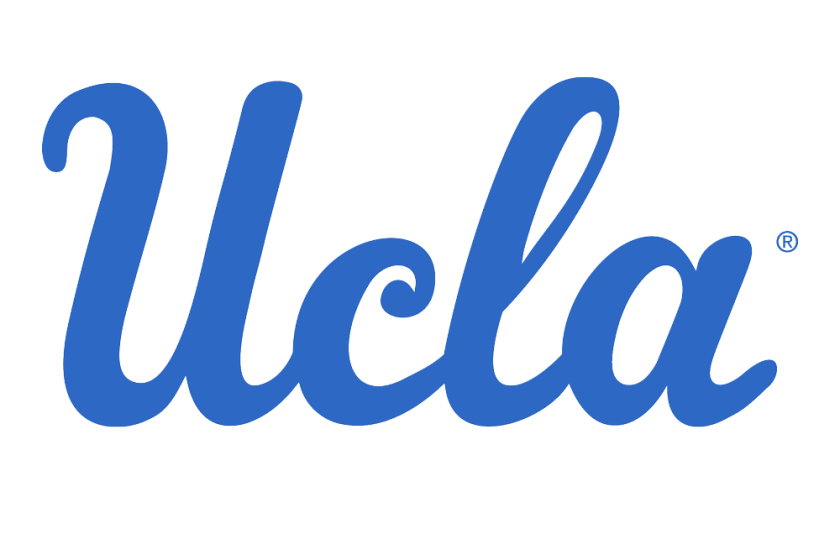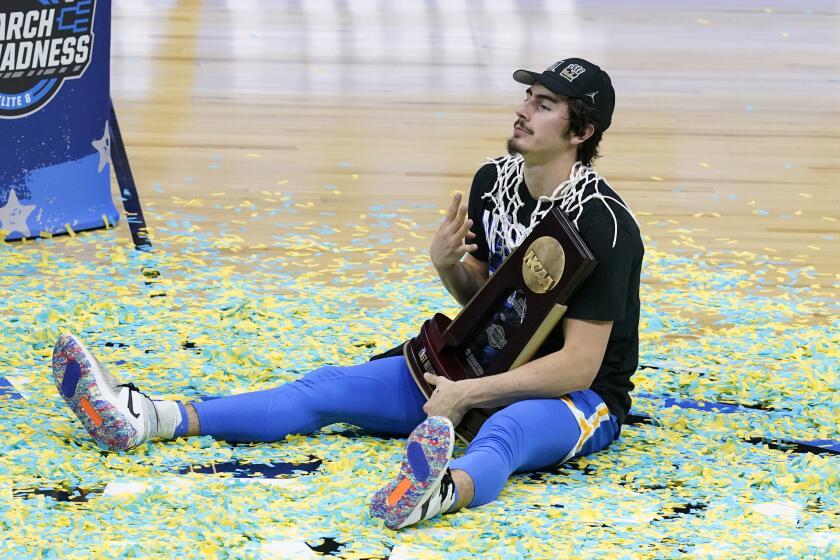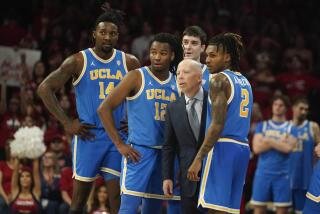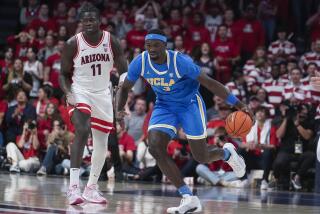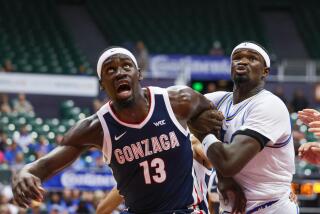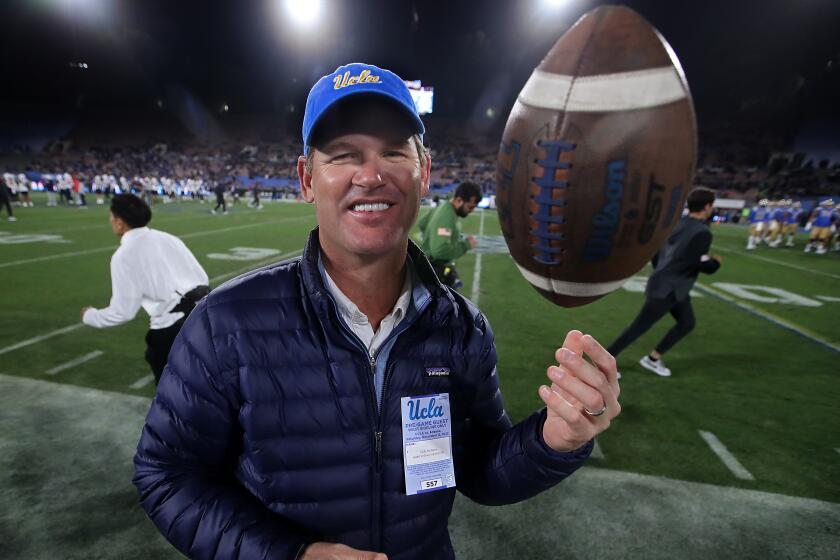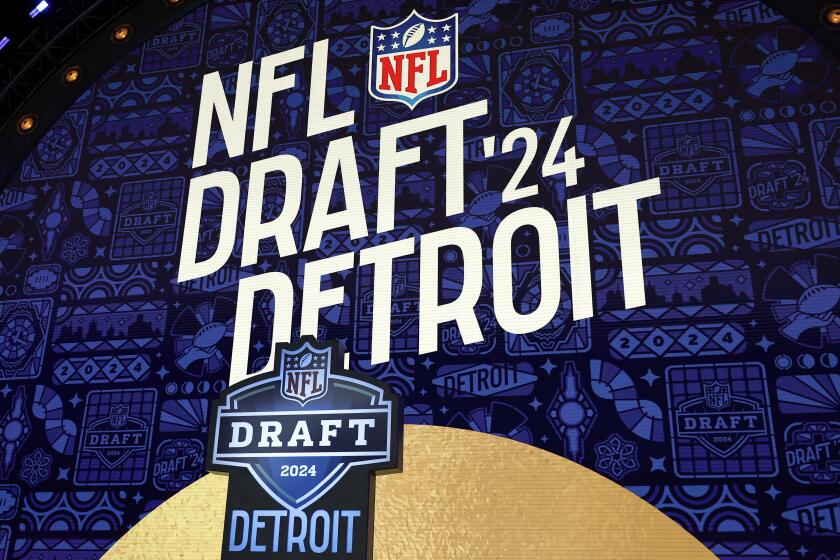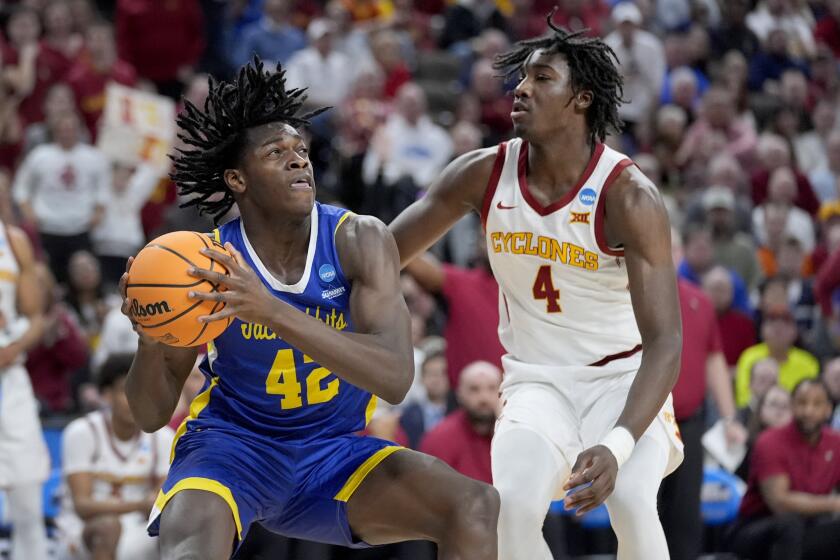‘Heartbreak city!’: With UCLA-Gonzaga on tap, Adam Morrison’s tears feel fresh again

Ryan Hollins swished his free throws. Jordan Farmar swiped away the ball and made the winning pass. Darren Collison jumped on a loose ball, securing another stolen possession. Gus Johnson, calling the action, affirmed the shock of a captivated nation that had just witnessed a comeback for the ages: “Unbelievable!”
These men all contributed significantly to the improbable story of UCLA-Gonzaga in the 2006 NCAA men’s tournament Sweet 16, but what they wouldn’t fully understand until later is that they were merely supporting actors in what would go down in history as the Adam Morrison Crying Game.
Johnson noticed it first, mid-histrionics, with 2.6 seconds left, after Collison had won the held ball — Morrison, the national player of the year, looking around Oakland Arena in pure horror, seeing that his 24 points had not been enough to stop the Bruins from turning a 17-point deficit into a one-point lead. CBS cameras captured Morrison with his mouth agape, and, even with time remaining for the Bulldogs to tie or win, he was on the verge of a breakdown.
“Heart! Break! City!” Johnson bellowed.
After J.P. Batista’s potential game-tying heave missed at the buzzer, Morrison fell to the floor face down and stretched out his 6-foot-8 frame, his dark brown mop of hair covering him as he gulped for air.
Wait one Wooden minute. Why are those Bruin players running across the court?
Seeing Morrison’s pain so visible, Johnson welled up too.
“That was the greatest kid. He was just a sweetheart,” Johnson recalled this week. “And every time I look at that, I dang near start crying again. I was in tears for him, and I’m calling the game. I thought it was one of the most courageous moments that I’ve ever seen in sports. For him to just release that kind of emotion in front of the whole world, that’s what makes this tournament so special. That picture. That moment there, in defeat, because what it tells you is, these aren’t professionals, these are kids. His heart was broken.”
The NBA chose Jerry West’s regal outline for its logo, but if college basketball wanted to pick a fitting emblem — one that particularly represents its diabolically cruel, single-elimination tournament — Morrison’s body sprawled on the court would suffice.
UCLA-Gonzaga ’06 has aged into one of the rare March Madness classics in which the loser’s image is the one that endures. With the Bruins and Bulldogs set to play in the Final Four on Saturday night, it was only natural to relive it. But, after 15 years, would the average sports fan even remember that UCLA was the team that sent Morrison spiraling and advanced to the national championship game?
Of course, Ben Howland didn’t design his Bruins to be some kind of national sensation. He wanted UCLA to play defense, work for a good shot on each offensive trip and ultimately win the game with toughness, not Hollywood flash.
“If you did not play defense, you did not play,” Collison said.
Ironically, it was little Gonzaga from Spokane, Wash., that had the star power and the intrigue of a former Cinderella story that had evolved into a No. 3 seed with legitimate championship aspirations.
Morrison and the Zags got hot early, while No. 2 seed UCLA couldn’t hit anything.
“They were kicking our butt,” Hollins said, “and Adam was trash talking us. We were as sound a defensive team as you could find, but Adam Morrison was the best player in the country by far. JJ [Redick] was getting his numbers at Duke, but he was better than JJ.”
UCLA sophomore Jaime Jaquez Jr. is carrying on a legacy that includes other former Mexican-American Bruins such as Earl Watson and Lorenzo Mata.
Said Johnson: “They were smoking UCLA, up 17. I’m calling the game with Len Elmore, we thought we were done, getting ready to empty the bucket as we call it. … You just say to yourself, there’s no way, especially with Adam Morrison.”
In the second half, there was no magic formula for UCLA to get back in it. The Bruins switched the taller Cedric Bozeman onto Morrison instead of Arron Afflalo, which seemed to cool Morrison a bit. Mainly, they whittled away at it, minute by minute.
“Our team as a whole had a lot of character,” Farmar said. “We were fighters, and we weren’t going to give up. That was our identity.”
Leon Rice, a Gonzaga assistant who now coaches Boise State, could not bring himself to watch the tape of UCLA’s comeback until six months later.
“I charted every possession,” Rice said, “and it was remarkable how everything had to go perfect for them down the stretch, and everything had to go wrong for us. If one of those events changed, they probably don’t win.”

UCLA-Gonzaga full Sweet 16 game from 2006 NCAA tournament
The final 40 seconds played out as pure terror for Gonzaga, which led 71-68 and had the ball. Morrison missed a jumper, and Batista was called for a foul on Hollins going for the rebound. Hollins, a 60% free-throw shooter, made both ends of a one-and-one. On the ensuing possession, the Bruins trapped Batista in the back court, and Farmar and Bozeman poked the ball out. Farmar lofted a pass to Luc Mbah a Moute for an easy layup and the lead. Then Gonzaga’s Derek Raivio bolted up court, looking for a game-winner, but Mbah a Moute punched it out from behind, and Collison corralled it. The possession arrow pointed UCLA’s way, and panic set in for Morrison, who did not respond to an interview request made through Gonzaga.
“That’s what made Adam so great,” Rice said. “My favorite thing about him wasn’t his scoring ability; it was that he was a killer competitor. That pain you saw was real. That dude hated to lose. He didn’t play basketball games to see who the best player was. He played to see who was toughest.”
UCLA, as it turned out, was tougher than Gonzaga. But that wasn’t official as Batista’s last-gasp attempt soared toward the hoop.
“Everything kind of stopped in that moment,” Farmar said. “You turn around and see: Are they the legendary ones or us?”
Said Hollins, “Your career and your life is hanging on that. You see the ball in the air, and you see life is changing.”
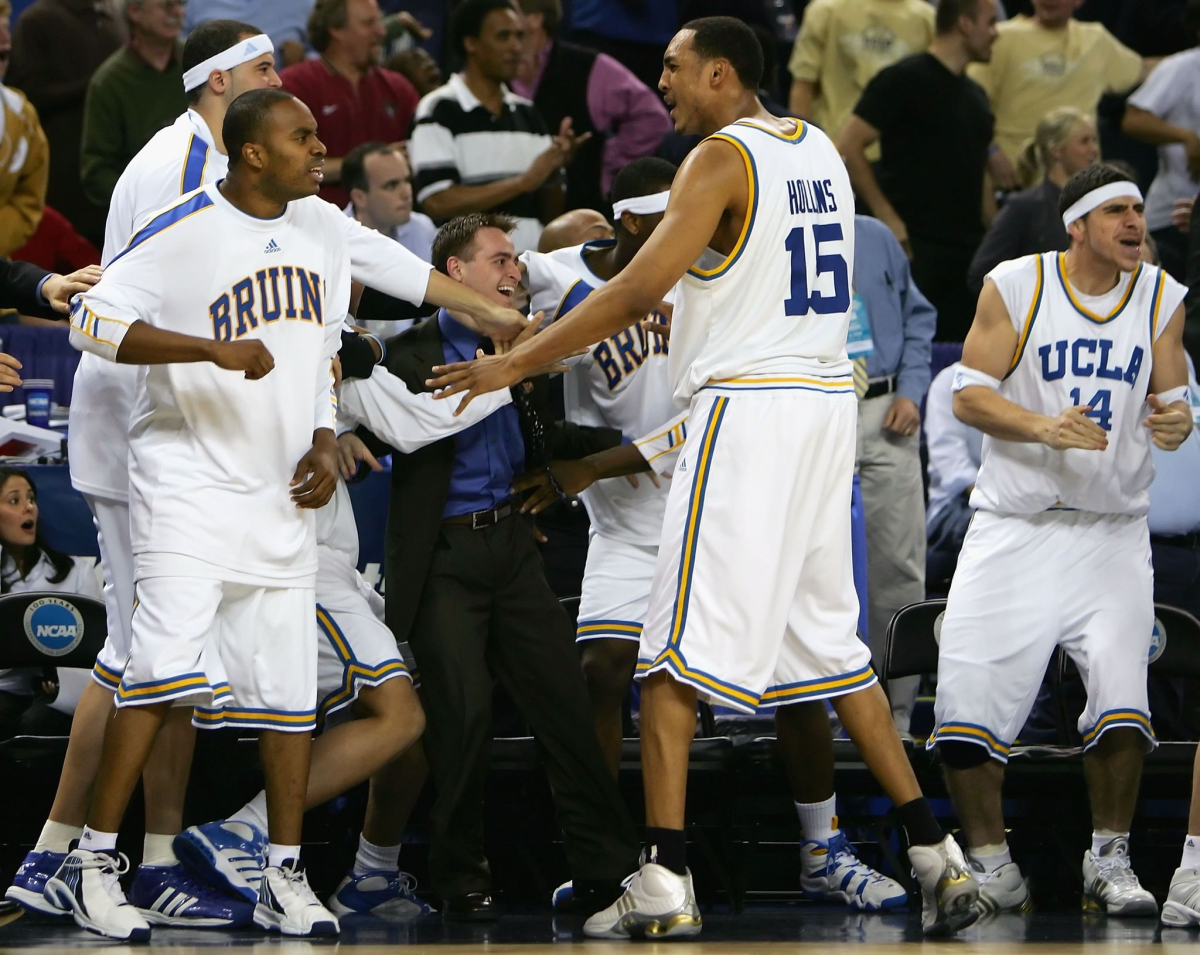
Looking back, Hollins thinks that game definitely changed his life. He feels that he would not have been drafted (he was picked in the second round, No. 50 overall) without getting to show his skills in the Elite Eight and Final Four.
An oft-forgotten detail is that it was two Bruins, Hollins and Afflalo, who found Morrison at half court and tried to pick him up.
“We let him know that it easily could have been and should have been us on the floor crying,” Hollins said. “We had so much respect for him, we couldn’t watch him lay there like that.”
Hollins is pretty sure that moment permanently altered the way he experiences the game he loves.
“You know what’s crazy? I’ve almost got, like, PTSD from that game,” he said. “If I watch a basketball game, and I see someone leave it on the floor or have a big comeback, I’ll get emotional, I kid you not. I get emotional over a game, because I’ve been there before, being a second away from either cheering or tears.”
“I get emotional over a game, because I’ve been there before, being a second away from either cheering or tears.”
— Former UCLA player Ryan Hollins
Farmar said he thinks about the Gonzaga game every year in March.
“As a kid, you watch March Madness and you see all these unforgettable, legendary type moments happen, and you dream of being in those positions,” Farmar said. “When you get a chance to sit back one year, two years, and now 15 years past, and you can still hear Gus Johnson making the call and see how impactful it was on college basketball, it’s pretty special.”
Johnson, who called his last NCAA tournament game in 2011 after leaving CBS for Fox, said it took him five or six years to get over not being a part of March Madness.
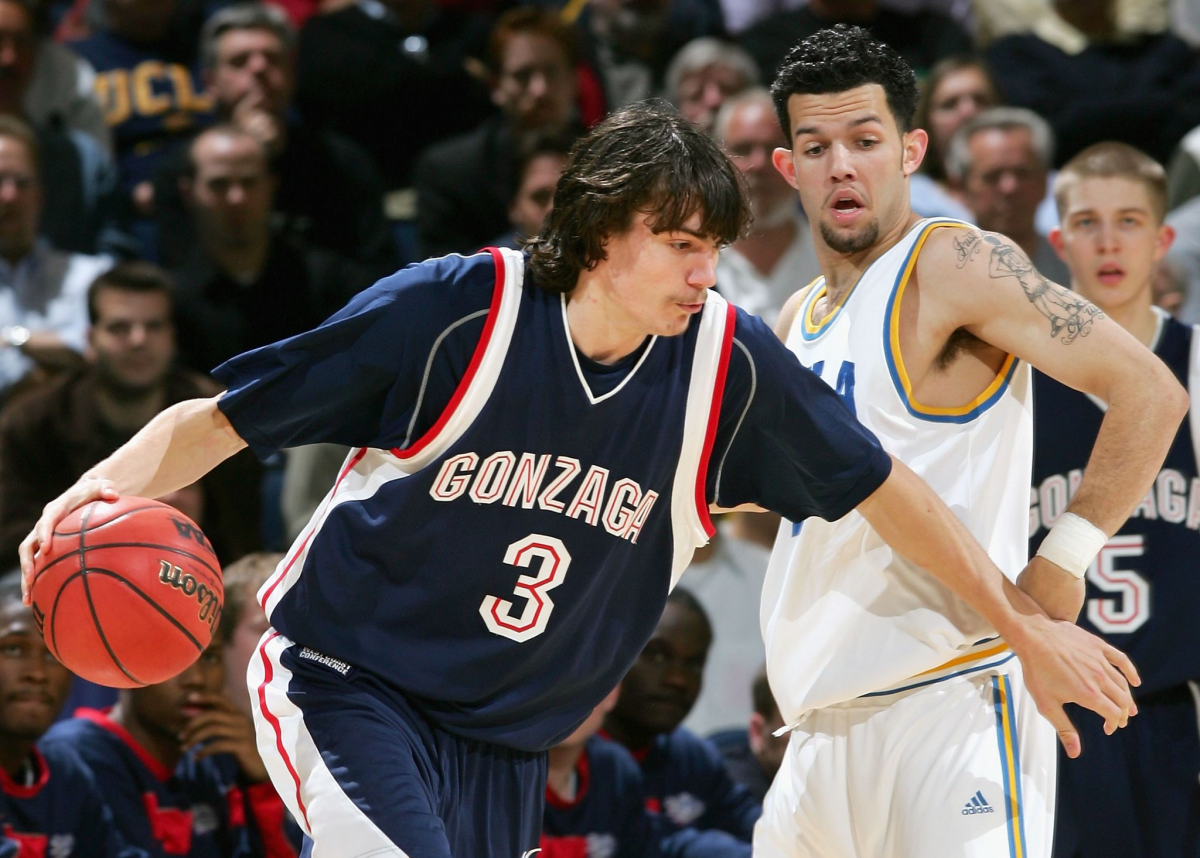
“You miss the kids, you miss the passion, you miss that innocence of a young man breaking down in front of the world, showing his emotions, letting you see how much he cared,” Johnson said. “As you get older, you lose some of that innocence. When I look into the eye of these kids, I just see it. There’s so much hope and promise. They’re dreaming.”
Gonzaga’s dreams were dashed that night, but the program kept pushing forward under coach Mark Few, who did not do the predictable thing and leave the Bulldogs for a traditional power. This weekend, the Bulldogs will go for the sport’s first undefeated season since the 1976 Indiana team.
“When you look back at that point of history, that was kind of the first time we started really thinking we could make a Final Four,” Rice said. “It was kind of an eye opener, like, we could have done this, why can’t we keep trying to get back there? It led to the thinking that has enabled Gonzaga to be where they are today.”
Mick Cronin will coach up-and-coming UCLA against Gonzaga, a powerhouse in the mold of John Wooden’s Bruins, in a Final Four game Saturday.
As for Morrison, he will be on the call for Gonzaga’s radio broadcast as the color commentator Saturday night. Maybe the emotions will come flooding back, or maybe he won’t let them.
He left Gonzaga after his junior season and became the No. 3 overall pick in the NBA draft to the Charlotte Bobcats. A year later, he suffered a severe knee injury and was never the same player.
“He could have been the next Larry Bird,” said Hollins, who played with Morrison in Charlotte.
Morrison thanked Hollins for his and Afflalo’s postgame gesture.
“He said it meant a lot to him that we did that, that we thought that highly of him,” Hollins said.

Over time, Morrison would come to appreciate any empathy he received for his tears, because in the sports world there wasn’t much of it.
On his first day with the Lakers in 2009, Morrison was greeted by photos of him crying taped all over the locker room.
“My teammates weren’t nice to him when he got signed,” said Farmar, then with the Lakers, too. “But he got over it.
“That’s part of the game. Anytime you’re a competitor, anytime you care ... he was emotional because it all just unfolded so quickly. Anytime you step in the ring, a boxer can get knocked out. I don’t feel sorry for him. We all signed up for it. That devastation is part of what shapes you.”
More to Read
Go beyond the scoreboard
Get the latest on L.A.'s teams in the daily Sports Report newsletter.
You may occasionally receive promotional content from the Los Angeles Times.

